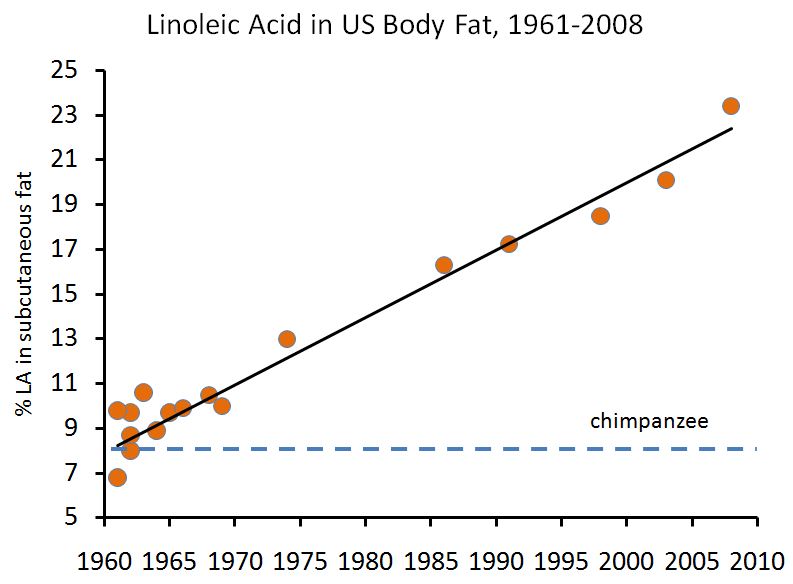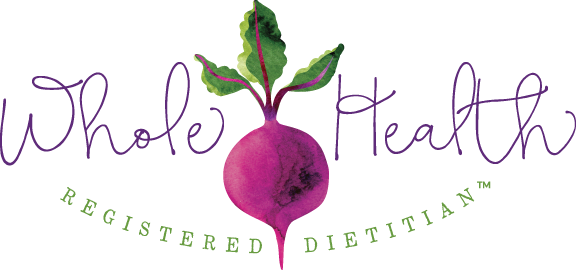Okay, take a stab at it. What do you think is the biggest dietary change in American history over the last 100 years?
Increase in refined sweeteners?
Increase in refined flour?
Increase in soft drinks? Fast food? Saturated fat? Carbs? Calories?
I think the biggest, and arguably most significant change in the American diet over the last century has been the development and mass adoption of seed and vegetable oils.

Think about your current diet. How many foods did you eat today that contained some sort of seed or vegetable oil? Corn, soybean, cottonseed, safflower, sunflower, grapeseed, canola oil…If you ate anything in a package or box, it likely contained one of these oils. If you ate at a restaurant, it’s likely your food was cooked in one of these oils. These oils have worked their way into nearly everything we eat, often even so-called health foods.
Before 1900, these oils were scarcely used. People used fats that could easily be extracted from food, like tallow, lard, butter, olive oil, and coconut oil. Seed and vegetable oils were used in paints and as furniture polish, until the development of chemical extraction methods made them cheaper and easier to obtain.
Seed and vegetable oils contain mostly polyunsaturated fats, like linoleic acid, a type of omega-6 fatty acid. I’m sure you’ve heard of omega-3 fatty acids? The balance of inflammatory omega-6 fatty acids to anti-inflammatory omega-3’s has changed from about 8:1 to about 20:1 in the past 100 years (1). In those years, saturated fat consumption has remained relatively stable, monounsaturated fat consumption increased by 54 percent, and polyunsaturated fat consumption increased a whopping 300 percent (2)!
And it’s not just from packaged, boxed foods either. These oils, in the form of corn and soy-based feed, are fed to pigs, chickens, and cows to fatten them up quickly. This changes the fatty acid composition of the meat, increasing the omega-6 fatty acids. However, grass-fed and pastured meat has fewer omega-6 fatty acids and more omega-3 than feedlot-raised meat.
As opposed to most other fatty acids, linoleic acid accumulates to a large degree in fat tissue, and over the past 50 years, it’s showing up in increasing quantities, including in breast milk (2,3).

Moreover, seed and vegetable oils are in nearly every store-bought beauty and personal care product you rub into your skin. Some interesting reading on that here.
So what’s the effect of eating all this linoleic acid day in and day out? Inflammation for one. Increased inflammation is associated with just about every disease, from heart disease, to diabetes, to autoimmune disease to cancer. Polyunsaturated fats are not very stable and go rancid (oxidize) easily when exposed to air, light, and warm temperatures. Think of the sticky neck of the vegetable oil bottle that you’ve had in the cupboard for while. Think of that in your body and on your skin.
“These oxidative processes can damage enzymes and other parts of cells, and especially their ability to produce energy. The enzymes which break down proteins are inhibited by unsaturated fats, and these enzymes are needed not only for digestion, but also for production of thyroid hormones, clot removal, immunity, and the general adaptability of cells. The risks of abnormal blood clotting, inflammation, immune deficiency, shock, aging, obesity, and cancer are increased. Thyroid and progesterone are decreased. Since the unsaturated oils block protein digestion in the stomach, we can be malnourished even while “eating well.” ” – Dr. Ray Peat (4)
Why do some experts recommend eating MORE of these fats? Studies show a substitution of saturated fats with polyunsaturated fats like linoleic acid can reduce cholesterol levels, but, this reduction in cholesterol levels does not translate into reduced mortality rates (5). And many experts are now questioning the widespread public health support for a high linoleic acid intake.
In a review paper on dietary fatty acids and heart disease risk that was published earlier this year that reviewed the the effect of dietary fatty acids on heart disease, the authors concluded:
“the pattern of findings from this analysis did not yield clearly supportive evidence for current cardiovascular guidelines that encourage high consumption of polyunsaturated fatty acids and low consumption of saturated fats. Nutritional guidelines on fatty acids and cardiovascular guidelines may require reappraisal to reflect the current evidence.” (6)
So, what to do? You don’t have to move to a farm and become a hermit to reduce omega-6 linoleic acid in your diet. Here are some pretty easy, actionable steps you can take to change your health for the rest of your life:
- Use olive oil, butter, and coconut oil at home, and quit buying and using vegetable oil, margarine, and shortening.
- Cook more at home and eat out less. Eat fewer fried foods at restaurants.
- Eat fewer packaged and boxed foods made with seed and vegetable oils. Be a label reader.
- Don’t buy mayonnaise or commercial salad dressings – make your own.
- If you eat meat, eat more grass-fed and pastured meats and vary your types. Many Americans OD on chicken, which can have a lot of linoleic acid, depending on how it was raised.
I believe there is enough evidence to reduce linoleic acid in my diet. If you need more convincing, Israelis’ high heart disease, diabetes, and cancer rates may be regarded as a population-based experiment of the effects of a high omega-6 diet (7).
Some food for thought.
1. http://chriskresser.com/how-too-much-omega-6-and-not-enough-omega-3-is-making-us-sick
2. http://wholehealthsource.blogspot.com/2012/02/my-tedx-talk-american-diet-historical.html
3. http://wholehealthsource.blogspot.com/2011/08/seed-oils-and-body-fatness-problematic.html
4. http://raypeat.com/articles/articles/unsaturated-oils.shtml
5. http://ajcn.nutrition.org/content/77/2/521.full




